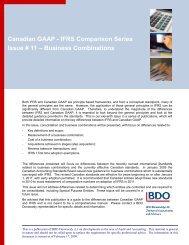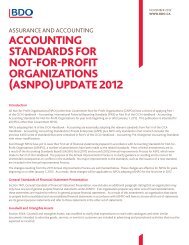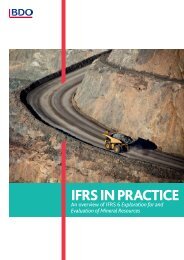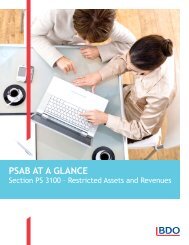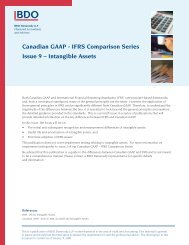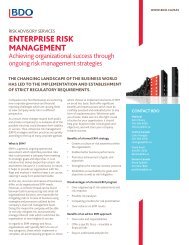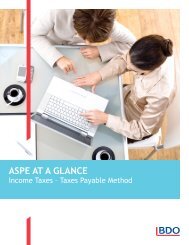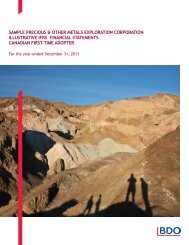need to know / leases - project update - BDO International
need to know / leases - project update - BDO International
need to know / leases - project update - BDO International
You also want an ePaper? Increase the reach of your titles
YUMPU automatically turns print PDFs into web optimized ePapers that Google loves.
LEASES - A PROJECT UPDATE<br />
9<br />
LESSEE ACCOUNTING<br />
Initial recognition and measurement<br />
At the date of commencement of a lease, a lessee would recognise and measure a right-of-use asset and a liability <strong>to</strong> make<br />
lease payments. The date of commencement of a lease is the date on which the lessor makes the underlying asset available<br />
for use by the lessee.<br />
The date of commencement of a lease may be different from the date of inception of the lease, which is the earlier of the<br />
date of the lease agreement and the date of commitment by the lessor and lessee <strong>to</strong> the principal terms of the lease; this<br />
can be earlier than the commencement date. In the 2010 ED, the IASB made a distinction between the recognition date<br />
(commencement of lease) and the date on which the lease assets and liabilities would be measured, which was the date of<br />
inception of the lease. This was similar <strong>to</strong> existing guidance in IAS 17. This approach was eliminated during redeliberations<br />
by the boards. Application guidance is <strong>to</strong> be included <strong>to</strong> cover costs incurred, and lease payments made, by lessees after the<br />
date of inception of a lease but before its commencement date. In addition, a lease might meet the definition of an onerous<br />
contract between its date of inception and date of commencement, meaning that the costs of the lease are greater than the<br />
economic benefits <strong>to</strong> be received from the use of the leased asset. In those cases, it would be accounted for in accordance<br />
with IAS 37 Provisions, Contingent Liabilities and Contingent Assets until the date of commencement.<br />
A lessee would measure its obligation <strong>to</strong> make lease payments at the present value of the lease payments, discounted using<br />
the lessee’s incremental borrowing rate or, if it can be readily determined, the rate the lessor charges the lessee.<br />
The lessee’s incremental borrowing rate is the rate of interest that, at the date of inception of the lease, the lessee would<br />
have <strong>to</strong> pay <strong>to</strong> borrow over a similar term, and with a similar security, the funds necessary <strong>to</strong> purchase a similar underlying<br />
asset.<br />
The right-of-use asset is measured at the amount of the obligation <strong>to</strong> make lease payments, plus any initial direct costs<br />
incurred by the lessee. Initial direct costs are those costs that are directly attributable <strong>to</strong> negotiating and arranging a lease,<br />
that would not have been incurred had the lease transaction not been entered in<strong>to</strong>.<br />
Any lease incentives provided by the lessor <strong>to</strong> the lessee would be deducted from the initial measurement of the right-ofuse<br />
asset. Where a right-of-use asset is amortised on a straight line basis <strong>to</strong> a nil residual value, the accounting result for the<br />
incentive will be the same as under current guidance in SIC-15 Operating Leases – Incentives, but it will be different where<br />
amortisation is not on a straight line basis.




